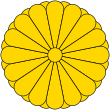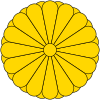House of Councillors (Japan)
House of Councillors (Japan)
Jump to navigation
Jump to search
This article's factual accuracy may be compromised due to out-of-date information. (January 2019) |
Coordinates: 35°40′35.5″N 139°44′40.5″E / 35.676528°N 139.744583°E / 35.676528; 139.744583
House of Councillors .mw-parser-output .noitalic{font-style:normal} .mw-parser-output .nobold{font-weight:normal} 参議院 Sangiin | |
|---|---|
 | |
| Type | |
| Type | Upper house |
| Leadership | |
President | Chūichi Date, LDP (caucus: independent) Since 1 August 2016 |
Vice President | Akira Gunji, Independent Since 1 August 2016 |
| Structure | |
| Seats | 242 |
 | |
Political groups | Government (151) LDP–PJK (126) Kōmeitō (25) Opposition (91) DPFP (24) CDP (23) JCP (14) Ishin (11) SDP–LP (6) Kibo (3) Energize (2) Okinawa Whirlwind (2) Independents (6) |
| Elections | |
Voting system | Parallel voting: Single non-transferable vote (146 seats) Party-list proportional representation (96 seats) Staggered elections |
Last election | 10 July 2016 |
Next election | July 2019 |
| Meeting place | |
 | |
| Chamber of the House of Councillors | |
| Website | |
| www.sangiin.go.jp | |
Japan |
|---|
 |
This article is part of a series on the politics and government of Japan |
Constitution
|
The Monarchy
|
Legislature
|
Executive
|
Judiciary
|
Administrative Divisions
|
Elections
|
Political parties
|
Foreign relations
|
Related topics
|
|
The House of Councillors (参議院, Sangiin) is the upper house of the National Diet of Japan. The House of Representatives is the lower house. The House of Councillors is the successor to the pre-war House of Peers. If the two houses disagree on matters of the budget, treaties, or designation of the prime minister, the House of Representatives can insist on its decision. In other decisions, the House of Representatives can override a vote of the House of Councillors only by a two-thirds majority of members present.
The House of Councillors has 242 members who each serve six-year terms, two years longer than those of the House of Representatives. Councillors must be at least 30 years old, compared with 25 years old in the House of Representatives. The House cannot be dissolved, as only half of its membership is elected at each election. Of the 121 members subject to election each time, 73 are elected from the 47 prefectural districts (by single non-transferable vote) and 48 are elected from a nationwide list by proportional representation with open lists.[1]
Contents
1 Current composition
2 Latest election
3 Historical notes
4 See also
5 References
6 External links
Current composition[edit]
(as of 23 October 2018 [before opening of 197th Diet])[2]
Caucus (English name) (domestic name) | Members | |||
|---|---|---|---|---|
| Term expires | Total | |||
| July 25, 2022 | July 28, 2019 | |||
| TBD Jiyūminshutō・Kokumin no Koe (Liberal Democratic Party, Voice of the People) | 57 | 69 | 126 | |
Komeito Kōmeitō (~"Justice/Fairness Party") | 14 | 11 | 25 | |
Constitutional Democratic Party and the Minyūkai Rikkenminshutō・Minyūkai | 16 | 8 | 24 | |
| | The Democratic Party for the People and the Shin-Ryokufukai Kokumin-minshutō・Shin-Ryokufūkai | 14 | 9 | 23 |
Japanese Communist Party Nihon Kyōsantō | 6 | 8 | 14 | |
Nippon Ishin no Kai (~"Japan Innovation/Restoration Association") | 6 | 5 | 11 | |
| Hope Coalition Kibō no kai (jiyū, shamin) (~"Assembly of Hope (LP, SDP)") | 4 | 2 | 6 | |
Kibō no Tō (~"Party of Hope") | 0 | 3 | 3 | |
| Independents Club Mushozoku kurabu | 0 | 2 | 2 | |
| Okinawa Whirlwind Okinawa no kaze (~"Wind of Okinawa") | 1 | 1 | 2 | |
| Independents (Members who do not sit with a caucus, includes Pres., Vice Pres.) | 3 | 3 | 6 | |
| Total | 121 | 121 | 242 | |
For a list of individual members, see the List of members of the Diet of Japan.
Latest election[edit]
| Party | Pre-election | SNTV/FPTP majoritarian | D'Hondt proportional | Seats won | New total | Change from | |||||||||||
|---|---|---|---|---|---|---|---|---|---|---|---|---|---|---|---|---|---|
| Total | Not up | Up | Votes[6] | % | Seats | Votes[6] | % | Seats | Before | 2013 | 2010 | ||||||
| Ruling parties | 135 | 76 | 59 | 69 | 145 | +10 | +10 | +42 | |||||||||
| Liberal Democratic Party | LDP | 115 | 65 | 50 | 22,590,793 | 39.94 % | 36 | 20,114,788 | 35.91 % | 19 | 55 | 120 | +5 | +5 | +36 | ||
| Komeito | K | 20 | 11 | 9 | 4,263,422 | 7.54 % | 7 | 7,572,960 | 13.52 % | 7 | 14 | 25 | +5 | +5 | +6 | ||
Revisionist opposition parties | 10 | 8 | 2 | 7 | 15 | +5 | (new +15) +6 from JRP | (new +15) | |||||||||
| Initiatives from Osaka | 7 | 5 | 2 | 3,303,419 | 5.84 % | 3 | 5,153,584 | 9.20 % | 4 | 7 | 12 | +5 | (new +12) | (new +12) | |||
| Party for Japanese Kokoro | 3 | 3 | 0 | 535,517 | 0.95 % | 0 | 734,024 | 1.31 % | 0 | 0 | 3 | 0 | (new +3) | (new +3) 0 from SPJ | |||
| Anti-revisionist opposition parties (joint nominations in single-member districts) | 79 | 27 | 52 | 40 | 67 | -12 | n/a | n/a | |||||||||
| Democratic Party | DP | 62 | 17 | 45 | 14,215,956 | 25.14 % | 21 | 11,751,015 | 20.98 % | 11 | 32 | 49 | -13 | (new +49) -10 from DPJ | (new +49) -57 from DPJ | ||
| Japanese Communist Party | JCP | 11 | 8 | 3 | 4,103,514 | 7.26 % | 1 | 6,016,195 | 10.74 % | 5 | 6 | 14 | +3 | +3 | +8 | ||
| People's Life Party | PLP | 3 | 1 | 2 | not contested independently | 1,067,301 | 1.91 % | 1 | 1 | 2 | -1 | -1 | (new +2) | ||||
| Social Democratic Party | SDP | 3 | 1 | 2 | 289,899 | 0.51 % | 0 | 1,536,239 | 2.74 % | 1 | 1 | 2 | -1 | -1 | -2 | ||
| New Renaissance Party | NRP | 2 | 0 | 2 | 60,431 | 0.11 % | 0 | 580,653 | 1.04 % | 0 | 0 | 0 | -2 | -1 | -1 | ||
| Happiness Realization Party | HRP | 0 | 0 | 0 | 963,585 | 1.70 % | 0 | 366,815 | 0.65 % | 0 | 0 | 0 | 0 | 0 | -1 | ||
Seitō shiji nashi ("no party supported") | 0 | 0 | 0 | 127,367 | 0.23 % | 0 | 647,071 | 1.16 % | 0 | 0 | 0 | 0 | (new 0) | (new 0) | |||
| Angry voice of the people | 0 | 0 | 0 | 82,357 | 0.15 % | 0 | 466,706 | 0.83 % | 0 | 0 | 0 | 0 | (new 0) | (new 0) | |||
| Others | 0 | 0 | 0 | 279,681 | 0.49 % | 0 | not contested | 0 | 0 | n/a | n/a | n/a | |||||
| Assembly to Energize Japan | AEJ | 3 | 2 | 1 | not contested | 0 | 2 | -1 | (new +2) -16 from YP | (new +2) -9 from YP | |||||||
| Okinawa Social Mass Party | OSMP | 1 | 1 | 0 | not contested | 0 | 1 | 0 | 0 | 0 | |||||||
| Independents (incl. some joint opposition-endorsed "independents" & 1 successful LDP-endorsed "independent") | 11 | 7 | 4 | 5,739,452 | 10.15 % | 5 | n/a | 5 | 12 | +1 | +9 | +10 | |||||
| Total (valid votes) | 241 | 121 | 120 | 56,555,393 | 100.00 % | 73 | 56,007,353 | 100.00 % | 48 | 121 | 242 | +1 (vacant) | 0 | 0 | |||
| Turnout out of 106,202,873 eligible voters | 58,094,005 | 54.70 % | 58,085,678 | 54.69 % | |||||||||||||
Historical notes[edit]
Article 102 of the Japanese Constitution provided that half of the councillors elected in the first House of Councillors election in 1947 would be up for re-election three years later in order to introduce staggered six-year terms.
The House initially had 250 seats. Two seats were added to the House in 1970 after the agreement on the repatriation of Okinawa, increasing the House to a total of 252.[7] Legislation aimed at addressing malapportionment that favoured less-populated prefectures was introduced in 2000; this resulted in ten seats being removed (five each at the 2001 and 2004 elections), bringing the total number of seats to 242.[7] Further reforms to address malapportinoment took effect in 2007 and 2016, but did not change the total number of members in the house.[7]
From 1947 to 1983, the House had 100 seats allocated to a national block (全国区, zenkoku-ku), of which fifty seats were allocated in each election.[7] It was originally intended to give nationally prominent figures a route to the House without going through local electioneering processes.[citation needed] Some national political figures, such as feminists Shidzue Katō and Fusae Ichikawa and former Imperial Army general Kazushige Ugaki, were elected through the block, along with a number of celebrities such as comedian Yukio Aoshima (later Governor of Tokyo), journalist Hideo Den and actress Yūko Mochizuki.[citation needed]Shintaro Ishihara won a record 3 million votes in the national block in the 1968 election.[citation needed] The national block was last seen in the 1980 election and was replaced with a nationwide proportional representation block in the 1983 election.[7] The national proportional representation block was reduced to 96 members in the 2000 reforms.[7]
See also[edit]
- List of Speakers of the House of Councillors of Japan
- List of districts of the House of Councillors of Japan
References[edit]
- Specific
^ Hayes 2009, p. 50
^ House of Councillors: Members Strength of the Political Groups in the House (only caucus totals and female members; full Japanese version partitioned by class/end of term and election segment 会派別所属議員数一覧)
^ Ministry of Internal Affairs and Communications: Results of the 24th regular election of members of the House of Councillors (in Japanese)
^ Yomiuri Shimbun: 2016 election results
^ Asahi Shimbun: 2016 election results
^ ab Decimals from proportionate fractional votes (按分票 anbunhyō) rounded to full numbers
^ abcdef "参議院議員選挙制度の変遷" [Changes to the electoral system of the House of Councillors] (in Japanese). Retrieved 12 December 2016..mw-parser-output cite.citation{font-style:inherit}.mw-parser-output q{quotes:"""""""'""'"}.mw-parser-output code.cs1-code{color:inherit;background:inherit;border:inherit;padding:inherit}.mw-parser-output .cs1-lock-free a{background:url("//upload.wikimedia.org/wikipedia/commons/thumb/6/65/Lock-green.svg/9px-Lock-green.svg.png")no-repeat;background-position:right .1em center}.mw-parser-output .cs1-lock-limited a,.mw-parser-output .cs1-lock-registration a{background:url("//upload.wikimedia.org/wikipedia/commons/thumb/d/d6/Lock-gray-alt-2.svg/9px-Lock-gray-alt-2.svg.png")no-repeat;background-position:right .1em center}.mw-parser-output .cs1-lock-subscription a{background:url("//upload.wikimedia.org/wikipedia/commons/thumb/a/aa/Lock-red-alt-2.svg/9px-Lock-red-alt-2.svg.png")no-repeat;background-position:right .1em center}.mw-parser-output .cs1-subscription,.mw-parser-output .cs1-registration{color:#555}.mw-parser-output .cs1-subscription span,.mw-parser-output .cs1-registration span{border-bottom:1px dotted;cursor:help}.mw-parser-output .cs1-hidden-error{display:none;font-size:100%}.mw-parser-output .cs1-visible-error{font-size:100%}.mw-parser-output .cs1-subscription,.mw-parser-output .cs1-registration,.mw-parser-output .cs1-format{font-size:95%}.mw-parser-output .cs1-kern-left,.mw-parser-output .cs1-kern-wl-left{padding-left:0.2em}.mw-parser-output .cs1-kern-right,.mw-parser-output .cs1-kern-wl-right{padding-right:0.2em}
- Bibliography
- Hayes, L. D., 2009. Introduction to Japanese Politics. 5th ed. New York: M.E. Sharpe.
ISBN 978-0-7656-2279-2
External links[edit]
- House of Councillors Website (in English)
House of Councillors internet TV - Official site (in Japanese)
Categories:
- Government of Japan
- National upper houses
- National Diet
- House of Councillors (Japan)
(window.RLQ=window.RLQ||).push(function(){mw.config.set({"wgPageParseReport":{"limitreport":{"cputime":"0.820","walltime":"1.082","ppvisitednodes":{"value":3420,"limit":1000000},"ppgeneratednodes":{"value":0,"limit":1500000},"postexpandincludesize":{"value":177707,"limit":2097152},"templateargumentsize":{"value":29251,"limit":2097152},"expansiondepth":{"value":13,"limit":40},"expensivefunctioncount":{"value":23,"limit":500},"unstrip-depth":{"value":1,"limit":20},"unstrip-size":{"value":8232,"limit":5000000},"entityaccesscount":{"value":1,"limit":400},"timingprofile":["100.00% 845.382 1 -total"," 36.08% 305.034 1 Template:Infobox_legislature"," 34.34% 290.325 1 Template:Infobox"," 21.85% 184.721 1 Template:Noitalics"," 20.64% 174.470 1 Template:Nobold"," 19.92% 168.423 1 Template:Lang"," 12.46% 105.320 1 Template:Reflist"," 11.06% 93.527 8 Template:Navbox"," 9.47% 80.028 1 Template:Japan_topics"," 9.02% 76.219 1 Template:Country_topics"]},"scribunto":{"limitreport-timeusage":{"value":"0.379","limit":"10.000"},"limitreport-memusage":{"value":14457397,"limit":52428800}},"cachereport":{"origin":"mw1274","timestamp":"20190105160351","ttl":1900800,"transientcontent":false}}});mw.config.set({"wgBackendResponseTime":94,"wgHostname":"mw1271"});});


